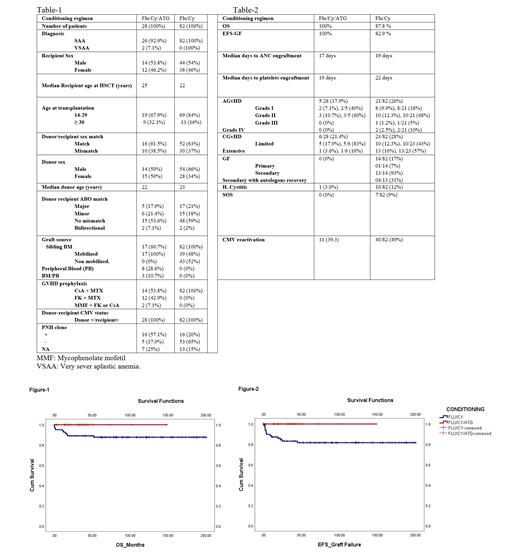ABSTRACT
Background: Matched sibling donor (MSD) allogenic hematopoietic stem cell transplantation (allo-HSCT) is the standard of care as the first line therapy for young fit patients with severe aplastic anemia (SAA). There are several conditioning regimens that have been evaluated and used for these patients. Fludarabine (Flu)/cyclophosphamide (Cy)/antithymocyte globulin (ATG) or Cy/ATG led to the best survival. The 5-year probabilities of survival after Flu/Cy/ATG, Cy/ATG, Cy ± Flu, and Busulfan /Cy were 91% (95% CI, 85-96), 91% (95% CI, 89-94), 80% (95% CI, 73-87), and 84% (95% CI, 75-91) (P = .001), (Bejanyan et al. 2019).
Objective: To report the outcome of a homogeneous cohort of SAA patients who received a uniform transplantation conditioning regimen protocol (Flu/Cy/ATG) and compare it with the historical protocol (Flu/Cy) from the same transplant center for the same patients population.
Methods: This study is a 10-year retrospective analysis of SAA patients who underwent MSD allo-HSCT at King Faisal Specialist Hospital & Research Centre, Riyadh City, Saudi Arabia during the period from 2013 to 2022. The conditioning regimen was consistent of Fludarabine 150 mg/m 2/Cyclophosphamide 200 mg/kg/ Anti-thymocyte globulin (rabbit) 2.5 mg/kg (Flu/Cy/ATG). Graft-versus-host disease (GVHD) prophylaxis was methotrexate (MTX)/tacrolimus (FK) or methotrexate/cyclosporin (CsA). The outcome was compared with the historical published data of 82 patients with SAA received Flu/Cy conditioning regimen for MSD allo-HSCT, (El Fakih et al. 2021).
Results: The study included 28 patients with SAA, 46.2% (n=12) patients were females, paroxysmal nocturnal hemoglobinuria (PNH) clone detected in 57.1% (n=16). Total body irradiation (TBI) was added to the conditioning regimen in 25% (n=7) for patients with heavily blood products transfusion pre-HSCT. A total of twenty-six patients (93%) has fully MSD, while 2 (7%) has matched unrelated donors (MUD). Bone marrow (BM) was the stem cell source in 60.7% while 28.6% received peripheral blood (PB) stem cell and 10.7 % received combined (BM/PB). There were twelve patients with donor-recipient sex mismatch. Major ABO mismatch counted for 17.9% (n=5). The median age at transplantation was 25 ±10.2 years. During the observational period, there was no graft failure (GF) and none of the patients died. At 60 days of HSCT; 61 % (n=17) patients achieved full donor whole blood (WB) chimerism, while 11 (39 %) patients had mixed chimerism. At both 180 days and 365 days of HSCT; 69.2% (n=18) patients had full donor chimerism and 30.8% (n=8) of the patients had mixed donor chimerism. Acute GVHD occurs in five cases (17.9%) and none had developed grade III or IV, notably; 80% of GVHD cases (4/5) received PB or BM/PB stem cell source. Chronic GVHD was observed in six cases (21.7%), 66% (4/6) of them had received PB or PB/BM stem cell source. The use of PB was due to either donor related reasons like recipient-donor weight discrepancy or patient's medical condition to achieve early engraftment. Hemorrhagic cystitis occurred in one case (3.6%), none had sinusoidal obstruction syndrome (SOS). CMV viremia without disease occurs in eleven patients (39 %). The median follow-up time for survivors was 34 months, the 2 years overall survival (OS) was 100%, the 2 years event free survival (EFS) defined with GF, or death was 100% compared with the previous result published (El Fakih et al., 2021) which had showen lower OS and EFS of 87.8% and 82.9% respectively with median follow-up of 100 months, Figure1&2. Table-1 and table-2 summarize the comparison of patient's characteristics and outcome of both regimens (Flu/Cy vs Flu/Cy/ATG).
Conclusions: The results of the present study showed better outcomes for SAA patients using Flu/Cy/ATG compared with the previous study (El Fakih et al., 2021). Early MSD allo-HSCT for SAA patients using Flu/Cy/ATG conditioning regimen is associated with a favorable outcome of excellent graft function, low rate GVHD and no GF. BM should be the stem cell source in severe aplastic anemia HSCT procedure.
Key Words: Severe Aplastic Anemia, Matched Sibling Donor, Conditioning, Bone Marrow Graft, Flu/Cy/ATG.
Disclosures
Alfayez:Novartis: Honoraria; Biologics: Consultancy, Honoraria; Abbvie: Research Funding; Astellas: Honoraria; AstraZeneca: Honoraria; Amgen: Honoraria; Johnson & Johnson: Consultancy, Honoraria, Research Funding; Pfizer: Honoraria.


This feature is available to Subscribers Only
Sign In or Create an Account Close Modal